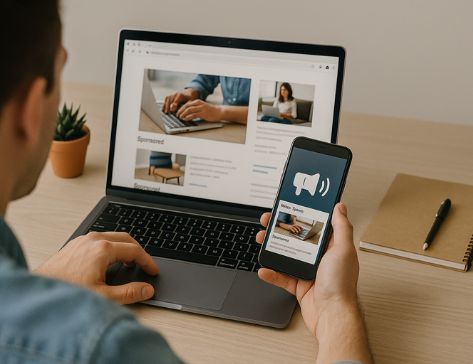
How to Combine Native Ads and Push Campaigns for Cross-Channel Conversions
Native ads and push campaigns are a powerful duo for driving cross-channel conversions when they are planned as one integrated strategy rather than isolated channels.
When you connect discovery-oriented native placements with timely mobile and web push notifications, you capture interest early and then reinforce it at moments that matter. This pairing lets you stretch creative assets across formats, amplify reach without cannibalizing budgets, and keep users progressing from awareness to action. For example, native ads can introduce a product and garner soft engagement, while well-sequenced pushes nudge opted-in users toward the next best step. If you’re looking for ways to scale revenue with smarter orchestration, see these cross-channel product recommendation strategies for inspiration on aligning content with intent.
Before we get tactical, it helps to clarify roles. Native ads match the look and feel of host content, earning attention through relevance and context. They excel at prospecting, content amplification, and mid-funnel education. Push notifications, in contrast, are opt-in, real-time prompts that shine for re-engagement, reminders, and conversion triggers. When you combine them, native builds curiosity while push supplies the momentum—reducing friction across the journey.
Trust also plays differently across channels. Native inventory often benefits from contextual trust because it sits alongside editorial or feed content, while push taps into the trust you’ve built with subscribers over time. Studies and industry debates continue about perceived credibility; for a useful perspective on message trust, review this discussion of native ads versus social ads and which builds more trust. The key takeaway is that trust compounds when messages are consistent and helpful across touchpoints.

Map the Customer Journey First
Start by drawing a simple path from first impression to purchase or other conversion: Awareness → Consideration → Intent → Conversion → Loyalty. Identify the specific jobs each channel will perform at each stage. For example, at Awareness, native should deliver bite-sized education and soft CTAs (e.g., “Learn more”). At Intent, push can activate urgency with personalized reminders (e.g., “Your cart is waiting” or “Offer ends today”). This clarity prevents channel overlap and clarifies measurement.
Align Creative and Message Hierarchy
Your best gains come from message consistency. Use a single creative narrative, then adapt it to each format:
- Hook: The scroll-stopping headline in native translates into the push title.
- Value prop: The main benefit becomes the first line of body copy in both channels.
- Proof: Use the same social proof (ratings, testimonial snippet, “trusted by…”) in native and push.
- CTA: Keep the CTA family consistent—e.g., “Get the guide” in native, “Open your guide” in push.
Keep file naming aligned so you can map creative variants across channels (e.g., brand_cnv_storyA_variant2). This helps with downstream reporting and creative fatigue checks.
Audience Targeting and Sequencing
Break audiences into three practical segments:
- Prospects: People reached for the first time via native. Objective: qualify interest and drive a soft click.
- Warm leads: Visitors who engaged with native content or site content. Objective: initiate opt-in for web or mobile push.
- Subscribers: Users who opted into push. Objective: orchestrate timely nudges that convert.
Sequence examples:
- Prospecting → Nurture: Serve a native article that educates. If the user clicks but doesn’t convert, trigger a push within 24–48 hours (where permission exists) summarizing the benefit and offering a next step.
- Intent capture: When someone views a product page from a native ad, queue an abandoned-view push if they don’t add to cart within a set time window.
- Post-conversion loyalty: After purchase driven by native, schedule pushes that onboard, teach usage tips, and upsell logical accessories.
Measurement That Respects Both Channels
Attribution is where many teams under-value push or over-credit the last click. Use blended KPIs and channel-specific diagnostics:
- Blended: CPA/CAC, revenue per visitor, and incremental conversion lift on cohorts exposed to both native and push versus native-only.
- Native diagnostics: CTR, quality clicks (e.g., scroll depth, time on page), assisted conversions.
- Push diagnostics: opt-in rate, deliverability, open rate, click rate, conversion rate, time-to-open.
Adopt experimentation patterns: geo-holdouts, cookie- or ID-based holdouts, and time-based suppression tests. Look for synergy effects—e.g., higher push open rates among users previously exposed to the native narrative compared with cold subscribers.
Proven Playbooks You Can Launch This Quarter
1) Content-to-Action Bridge
Create a native article that highlights a pain, then a solution. Ensure the landing page offers a lead magnet with a low-friction form. When the user opts in to push, schedule a follow-up notification summarizing the three key benefits and linking to a short demo. The tonal continuity—same headline family, same benefit language—reduces decision fatigue and boosts conversion.
2) Offer Countdown with Soft Intro
Use native placements to introduce a limited-time offer with context and credibility. Onsite, collect push permission with clear value exchange (alerts for price drops, early access). Push cadence: T–48h reminder (“preview ends soon”), T–6h urgency (“6 hours left”), T–1h final nudge (“last chance”). Keep frequency caps to avoid fatigue and exclude recent purchasers.
3) Abandoned Read → Re-engage
When a user clicks a native article but bounces early, send a push within 24 hours that reframes the hook in more concrete terms and promises a quick takeaway (“2-minute guide inside”). If the user returns and finishes the piece, chain a second push offering a related checklist that transitions toward product consideration.
Creative Craft: What Works Across Formats
- Lead with outcomes: Headlines that promise a result (“Cut onboarding time by 30%”) outperform abstract benefit claims.
- Mirror the environment: Native thrives on contextual resonance; adjust tone to the publisher vertical, then echo that tone in push.
- Use modular visuals: Design hero images and icons that crop cleanly for feed cards and push-rich media.
- One CTA, many doors: Keep your CTA family tight across formats to reinforce the next action.
Compliance, Respect, and Deliverability
Push is permission-based. Make your value exchange explicit (“Get early access drops and how-to tips”). Offer granular controls (frequency and topic), and provide easy opt-out. For native, label clearly as sponsored and avoid deceptive UI. On deliverability, test push send windows by timezone, throttle notifications during quiet hours, and monitor soft vs. hard bounces. Prioritize message usefulness—alerts, saved items, restocks—over purely promotional blasts.
Operational Tips and Tech Stack Notes
- Taxonomy: Use shared naming across channels for campaigns, ad sets, and creatives. It simplifies analysis and cross-team communication.
- UTM hygiene: Standardize utm_source, utm_medium, and utm_campaign for native and push so multi-touch modeling isn’t polluted.
- Suppression lists: Exclude recent converters and high-frequency openers from broad pushes; exclude unsubscribed or dormant users to protect sender reputation.
- Creative rotation: Set fatigue thresholds for native (e.g., impressions per user) and push (e.g., weekly frequency) and auto-rotate variants.
- Data feedback: Pipe push engagement back to native prospecting—high openers/Clickers can seed lookalike audiences.
Quick diagnostic: If native CTR is healthy but downstream conversion lags, inspect message continuity from native headline → landing page H1 → push title. Inconsistent framing is a common friction source.
Common Pitfalls to Avoid
- Channel myopia: Optimizing native for CTR alone or push for open rate alone can harm blended CPA; optimize for downstream value.
- Over-sending: Push fatigue corrodes opt-in lists. Cap frequency and build in snooze logic after multiple non-opens.
- Generic personalization: “First name only” personalization underwhelms. Use behavioral cues (browse history, recency) to tailor messages.
- Attribution tunnel vision: Last-click bias will under-credit assistive touchpoints. Run holdout tests and report incrementality.
Conclusion: Orchestrate, Don’t Just Add Channels
When you treat discovery and activation as a single narrative, native ads and push campaigns multiply each other’s strengths. Native earns attention with context and credibility; push converts attention into action with timing and personalization. Start with a simple journey map, align your message hierarchy, and measure blended impact. If you’re exploring ways to research creative angles and competitive placements to inform your native strategy, tools like Anstrex Native Ads can be useful, while your push stack keeps the momentum going after the first click. With tight orchestration, you’ll see higher-quality leads, faster sales cycles, and more resilient cross-channel conversions.


